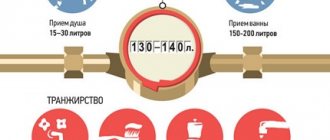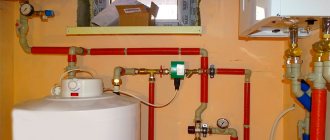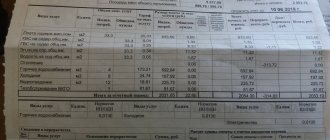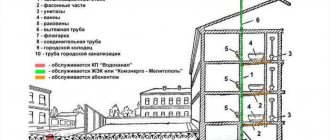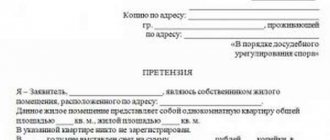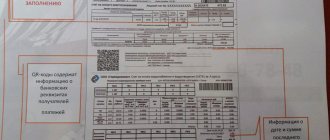Concept
Providing residents with cold and hot water, including their disposal, are among the public services that consumers receive from utility services. This includes:
- Preparation and supply of cold water . It involves the preparation of drinking water and takes place in several stages.
- Preparation and supply of hot water . We are talking about servicing boiler houses that heat water. The service is not provided if there is an individual hot water supply (gas water heaters or autonomous boiler houses).
- Drainage. Removal of used water from apartments of building residents.
Drainage is presented as a separate line item on the receipt. It is provided on the basis of regulatory legal acts. It involves the removal of already used water and its disposal through the sewer system. Drainage scheme:
- Discharge of used water.
- Supply to treatment facilities.
- Cleaning process.
- Disposal according to current regulations.
- Wastewater disposal.
All issues related to this service are reflected in the Law “On Water Supply and Sanitation”. It specifies provisions for the supply of water to residential premises at any temperature and appropriate quality. Before its adoption, water disposal was regulated by the Decree of the Government of the Russian Federation and regulations.
ATTENTION! All organizations providing this service must meet the requirements of the law. They must draw up production control programs and fully implement them.
Plumbing in a private house
The systems under consideration are interconnected, which means that these circuits need to be designed simultaneously. The process of drainage in a private house implies that it is necessary to organize not only the drainage of domestic water, but also the consequences formed as a result of precipitation.
Today, every residential area has an autonomous type system for draining water. It is located 10-15 meters from the premises. The deeper and wider the drainage system is dug, the more wastewater can be removed.
Differences between water supply and sanitation
Both utilities differ significantly from each other. The essence of water supply is that before entering the apartment, cold water is purified and disinfected, and hot water is heated to the required temperature. Water disposal is the removal of waste water from a living space and its disposal through the sewer system.
The technical process is complex and consists of several stages. After use, water is supplied to treatment facilities, where it undergoes stages of purification and subsequent disposal.
Interrelation of water supply and sewerage systems
When constructing new cities and towns, renovation and improvement, the design of water supply and sewerage mains is closely linked. This is a difficult job, because the installation scheme for water consumption and drainage systems must be planned even before the construction of building foundations. Moreover, this applies to both internal and external networks.
If water and sewer pipelines are laid in built houses, the process becomes more complicated. Exits must be created in finished walls without compromising their load-bearing qualities.
When installing and operating networks for the supply and removal of liquids, compliance with sanitary and construction standards is mandatory. They include the organization of security zones, compliance of supplied water with state standards and samples, automation of labor-intensive processes and the use of modern technologies.
Procedure and grounds for calculating payment
Water disposal contains standards for payment of housing and communal services. In Russia there is no single tariff used to provide services such as sewerage . Several nuances influence its establishment:
- Availability of special metering devices in the apartment.
- The region where the apartment is located.
- The maximum tariff rate is set at the local government level.
- Establishment and application of preferential conditions.
If a residential building is controlled by a management company, then the tariff is determined based on the percentage of service provided. To do this you need to keep in mind:
- Volume of liquid waste.
- Total mass of wastewater.
- Other indicators that form the cost of the service.
You can save on wastewater disposal if you use water rationally.
Automation of the water supply process
The volume of water available for pumping from a well or well (do-it-yourself plumbing in a private house) may vary depending on the intensity of use and time of year.
It may happen that at some point the water in the well will run out, and the pump will continue to work, pumping air into the system.
To control the operation of the pump and prevent its failure, an automation unit is provided.
First comes the pressure switch.
A pressure gauge is installed on it for visual control (read how to choose a water pressure regulator in an apartment on this page).
When the pressure increases or decreases by more than the specified values, the water supply automatically stops.
Next comes the idle speed sensor . It monitors the presence of water in the system, and if it is insufficient or absent, it also turns off the pump.
Despite the fact that the pump power is sufficient to lift water from a considerable depth, the pressure in the system cannot be constantly stable.
Sometimes, it is not high enough for comfortable consumption on the upper residential tiers, or for operating a washing machine or dishwasher.
To stabilize the pressure, use an expansion tank or a hydraulic accumulator.
Structurally , it is a metal case with a rubber membrane or bulb located inside.
Expansion tanks are used for both plumbing and heating systems.
Their operating principle and appearance are approximately the same, so they are sometimes confused and the one intended for another system is installed.
Main difference:
- in hydraulic accumulators for water supply,
- the incoming water is inside the rubber tank,
- in those intended for heating systems - outside, and in contact with the outer metal walls.
How to calculate correctly
It is impossible to set the total amount to be paid. But you can make an approximate calculation of the expected amount. The formula used for calculation is:
(HW+HW+CO)×T
Where:
HW - volume of hot water used,
ХВ - volume of consumed cold water,
СО - waste,
T is the tariff, which has its own value in each region.
Meter readings are used for calculations. If they are not installed, you should rely on local consumption standards. They are recalculated annually.
They can be viewed on the administration website. However, the indicator does not take into account the consumption spent on watering indoor flowers, as well as other volumes that are not drained into the sewer.
A receipt for residents of an apartment building may contain the wording “Water disposal for common building needs,” which implies the calculation of the service according to a common building meter, and not on an individual basis.
If the homeowner prefers to pay for the service based on personal consumption, it is necessary to install a meter in his apartment. Before installation, the management company must be notified and issue the appropriate permit. After that, a seal is installed on the meter, and a recalculation is made on the receipt.
Rules for use and provision
Water, which is intended for food and household use, is sent to the premises from the organization providing these services. Apartment owners enter into agreements with these companies. Such relations are regulated through the provisions of the Civil Code.
In accordance with this agreement, payments are made for consumed resources. The document specifies the rules for calculating the amount. In a situation where the use of water occurs without the conclusion of the act in question, this is a violation.
The guilty person is held accountable under the Code of Administrative Offenses and the Criminal Code of the Russian Federation, as stated in the table:
| Punishment of the Code of Administrative Offenses | Criminal Code sanctions |
| Fine for citizens in the amount of 1,000 to 1,500 rubles, for organizations from 20,000 to 30,000 rubles | Fine from 200,000 to 300,000 rubles, forced labor for up to 2 years, imprisonment for 2 years |
A similar procedure applies to the drainage system.
Possible nuances
The amount of utility bills is affected by several nuances that the management body must keep in mind. For example, a certain category of people has the right to make a payment with a reduced amount. To confirm the right to benefits, citizens must provide relevant documents.
The total amount of all reductions (subsidies or compensation) depends on the category of benefits used by homeowners. It is also influenced by the number of people living in the apartment, as well as the total family income.
The list of established benefits can be found in the territorial division of social protection of the population. Only those citizens who have no debts for housing and communal services can apply for their registration. If they are available, they must be paid in advance before applying for benefits.
ATTENTION! A utility should not offer benefits on its own. They are provided only after presentation of documentation.
All owners whose utility bills exceed 20% of their total income can apply for the benefit.
Water consumption
LLC "***" for the needs of the enterprise extracts underground water from well No. *** (license No. *** No. *****) in the amount of 595 m3/day (148,129 m3/year) and receives it under an agreement from the OJSC “****” (contract No.) in the amount of 50 m3/day (12,450 m3/year).
Water intake well No. *** “T” is located in ****, which in hydrogeological terms is a system of small artesian basins filled with sandy-clayey Pliocene deposits and separated by anticlinal ridges composed of practically waterproof Miocene rocks.
Below is a brief hydrogeological description of the aquifer complexes of this basin.
The aquifer of Quaternary sediments (Q) lies to a depth of 17-25 m. The horizon is composed of loams and clays with rare interlayers and lenses of fine-grained sands, often clayey. The water abundance of the horizon is characterized by well flow rates of 0.5-2.0 m3/hour with a level drop of 0.1-1.5 m. In terms of the chemical composition of the water, calcium sulfate water does not comply with SanPiN 2.1.4..1074-01 “Drinking Water”, in terms of dry residue - up to 3 g/l and in terms of total hardness - up to 12 mEq/l. .
The aquifer of undifferentiated deposits of the Upper Pliocene lies in the depth range from 17-20 to 140-145 m. The water abundance of the complex is characterized by well flow rates of 10-18 m3/hour with a drop in water level of 12-20 m. The filtration coefficient is 3.5 m/day , water conductivity 120 m3/day, piezoelectric conductivity - 5x 10 m/day.
Piezometric levels are currently installed at a depth of 12-15 m from the earth's surface. The hydraulic slope is 0.0008 when the groundwater flow is directed westward.
The chemical composition of the water is hydrocarbonate-chloride-sulfate, calcium-sodium. The dry residue is 1.7-3.2 g/dm3, the total water hardness of the horizon is 8-22 mmol/dm3.
The aquifers of the Upper Pliocene complex are fed by the flow of water from the overlying aquifers.
The aquifer of Cimmerian deposits lies in the depth range from 140-145 m to 210-220 m and is represented by 2-3 aquifers. The thickness of individual sand layers ranges from 9 to 15 m, their total thickness reaches 30 m.
The water abundance of the complex is characterized by well flow rates of 15-30 m3/hour with a drop in water level of 20-33 m. The filtration coefficient is 5 m/day, water conductivity is 150 m2/day, and piezoelectric conductivity is 5 x 105 m2/day. Pizometric levels are set at levels from 1.5 m below the earth's surface to +2.0 m above it, the hydraulic slope is 0.002 when the groundwater flow is in the western direction.
The chemical composition of the water is sodium chloride with mineralization up to 1 g/dm3 and a total hardness of 2.5-3.9 mmol/dm3. An increased content of hydrogen sulfide is noted.
The waters of the Cimmerian horizon are widely used throughout the area for economic purposes.
The first belt of the sanitary protection zone is allocated (12m in the western direction, 9m in the northern direction, 16m in the eastern direction, 21m in the southern direction), the site is landscaped and landscaped, fenced with a mesh fence with lockable metal gates. There are paved paths. On the territory of the 1st belt zone, weeds and undergrowth are regularly cut down. A concrete blind area was made around the wellhead with a width of 1.5 m and a depth of 0.7 m to prevent the possibility of production horizons. At the entrance to the water intake area there are signs “Strict security sanitary protection zone” and “Unauthorized entry is strictly prohibited”
The territory of LLC “***” falls within the sanitary protection zone of the second zone of the water well. The sanitary protection zone of the second zone has the form of a circle around a well with a radius of 60 m and is confined to an area where there are no sources of microbiological pollution, and the exploited aquifers are classified as protected. The existing production buildings of LLC "***" are sewered, the territory of the enterprise is asphalted.
The sanitary protection zone of the third belt is an ellipse around the well (upstream in the northwest direction 728 m, downstream 364 m, perpendicular to the flow in both directions 593 m). The third zone zone includes both the territory of LLC “***” itself and private households of Art. ***, adjacent areas free of buildings and agricultural land. There are no obvious sources of chemical pollution of groundwater within the third level of sanitary protection. The territories are paved, the premises are sewered, a network of rain sewers and storm drains is provided, etc. Agricultural lands falling within the third belt of the sanitary protection zone are used without introducing highly toxic fertilizers into the soil. Wastewater is discharged into the in-plant sewerage system and then released into a storage pond at a distance of about 5 km from the wellhead. Vehicle parking areas and railway tracks falling within the third belt zone cannot be a source of groundwater pollution, since the exploited aquifers are classified as protected, and the necessary set of special measures have been carried out on the territory of parking lots aimed at preventing groundwater pollution: the areas are paved with asphalt, network of storm sewers and storm drains, etc.
Is it possible not to pay?
The sewerage fee is a payment established by regulations. This is not an invention of the management company. Housing and communal services are paid for the fact that used water is disposed of in a purified form, and not simply drained into the street.
To clarify information about the obligation to pay for sewerage, you can make a written request to the utility service. This category of beneficiaries mainly includes low-income people whose total income is below the established subsistence level.
The concept of sewerage payments for utilities in 2021
What should be understood by the term “sewage” in utility bills is reported in, which has accumulated numerous provisions of local and federal laws. Some of them are still relevant and regulate, for example, requirements for the quality of water supplied to apartments and discharged into natural reservoirs, as well as tariffs for its use.
The provision of public sewerage services is also regulated by the river. VII Housing Code of the Russian Federation. Residents and premises owners are required to pay for the receipt and disposal of used resources. The document contains the procedure for calculating and sanctions for the occurrence of debt for housing and communal services.
The latest changes to the Code, adopted in July last year, concern resources spent on general household needs. The Housing Code and recently adopted acts explain what sewerage is in utility bills in 2021, and why drainage at one-way service stations is excluded from them.
To determine the amount of water drained into the sewer, the following are used:
- readings of individual meters for hot and cold water;
- average monthly consumption standards.
It is believed that the volume of water used and drained into the sewer is equal to the total amount of the resource received at any temperature.
Taking into account the amendments made to the legislation, the costs of drainage of general wastewater should be included in the costs of maintaining the property of the apartment building. Their volume is calculated:
- using standards established by authorities at the regional level;
- taking into account the amount of resource supplied according to public meters.
If the latter are not available in the house, water supply control units are taken as a basis. Thus, an HOA, management company or cooperative does not have the right to display “Water disposal for the maintenance of collective property” in a separate line.
Rate
The reason lies in the peculiarities of the waste disposal process and the climate conditions of the region. However, tariffs for these services should be approximately the same.
Most often, the tariff size is determined based on average indicators. Sometimes the management company may set reduced rates due to the use of a new recycling system that reduces costs.
In some situations, the management company may make mistakes in utility calculations . If they are identified, the consumer of the service must contact the management company employees with a written statement. The form is free, but contains the following information:
- The essence of the problem.
- Personal data.
- Name of the governing body.
- The address of the apartment to which the receipt with incorrect calculations was received.
- Phone number.
The appeal must be registered. It is drawn up in 2 copies, one of which must bear the date of acceptance, the employee’s signature and its transcript.
Filtration system
At the intake level, the water may become contaminated with sand, silt or small debris.
To ensure an acceptable level of water quality, a filtration system is installed at the entrance to the house.
These are sequential filters of different designs, each of which performs its own role.
First comes the coarse filter.
It is a vertically located metal container in which water moves in a spiral.
Suspended sand particles and small debris settle at the bottom.
A drain valve is provided at the bottom, through which, under pressure, deposits are periodically removed.
After the coarse filter, two or more fine filters are installed.
These are plastic flasks (usually transparent, which facilitates visual inspection) into which replaceable cartridges made of polyethylene thread are inserted.
Here the water is filtered from suspended matter at the microscopic level.
The last one is a filter with carbon filler , where the water is purified at a biological level and its taste is slightly improved.
The durability of faucets, ball valves and household appliances that consume water largely depends on how high-quality the filtration system is installed at the entrance to the internal system.



